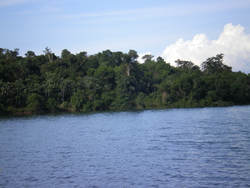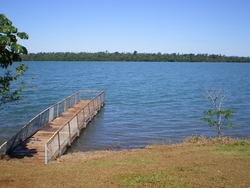
Reserva Itabó
Encyclopedia
The Itabo Biological Reserve is located in the district of Hernandarias
, Alto Paraná Department
, Paraguay
, on the right bank of the river Paraná, and is one of the 8 as sites for ecological reserve by the Itaipu dam, the largest dam in production in the world, located between Paraguay and Brazil. It is located at 80 km north of the city of Hernandarias
. Their access routes are the backbone 1 and 2. It has an area of 15,208.
 It has a slightly undulating topography. The river Itabo Reserve crosses from west to east with their two arms, Itabo North and South and some tributaries.
It has a slightly undulating topography. The river Itabo Reserve crosses from west to east with their two arms, Itabo North and South and some tributaries.
Its boundaries are: north to the Cologne Gral. Diaz, south establishing livestock Loma Porá, the Cologne to the east and west Pikyry Colonies Gleba 2 and Gleba 3.
The soils of the biological reserve Itabo, are derived from basaltic rocks. They are classified as laterite and latozoles, have reddish brown colour, texture of silt and clay are usually good depth.
, ybyrá pytá, cedar
, cancharana, petereby, guatambú, peroba
incense
, curupay, ybyraró
, among others. In the lower strata plants are species of the family Myrtaceae
, as ñangapiry, Guava
, yva poroitý, and so on.
The tapestry has countless herbaceous species of the family bromeliads, as well as tree ferns.
We have classified 40 species of mammals, 250 bird species and 20 species of reptiles.
Stress for its abundance: taitetú
, mboreví
, guazú
, spirits' i
, akuti sa'yjú, coati
among other listed species.
Among the birds we can cite the heron boyer
, Hoke guazú, mbiguá, duck Braga, osprey
, yryvú ruvichá
, tingazú
.
Among the reptiles were observed yarara
, coral
, lies.
 According to latest techniques of management of protected areas, the biological reserve of Itabo is divided into distinct zones in order to handle them properly.
According to latest techniques of management of protected areas, the biological reserve of Itabo is divided into distinct zones in order to handle them properly.
The reserve has a panoramic viewpoint, which can be seen most of the wooded area, as well as the vast body of water formed by the dam. The combined resources of vegetation, topography and water give it a priceless
Hernandarias
Hernandarias may refer to:* Hernando Arias de Saavedra, the first American-born governor in South America.* Hernandarias District, in Alto Paraná department, in Paraguay.* The Hernandarias Subfluvial Tunnel, joining Santa Fe and Paraná, in Argentina....
, Alto Paraná Department
Alto Paraná Department
Alto Paraná is a department in Paraguay. The capital is Ciudad del Este .The Alto Paraná department has experienced tremendous economic and population growth in the past 50 years...
, Paraguay
Paraguay
Paraguay , officially the Republic of Paraguay , is a landlocked country in South America. It is bordered by Argentina to the south and southwest, Brazil to the east and northeast, and Bolivia to the northwest. Paraguay lies on both banks of the Paraguay River, which runs through the center of the...
, on the right bank of the river Paraná, and is one of the 8 as sites for ecological reserve by the Itaipu dam, the largest dam in production in the world, located between Paraguay and Brazil. It is located at 80 km north of the city of Hernandarias
Hernandarias
Hernandarias may refer to:* Hernando Arias de Saavedra, the first American-born governor in South America.* Hernandarias District, in Alto Paraná department, in Paraguay.* The Hernandarias Subfluvial Tunnel, joining Santa Fe and Paraná, in Argentina....
. Their access routes are the backbone 1 and 2. It has an area of 15,208.
Geography

Its boundaries are: north to the Cologne Gral. Diaz, south establishing livestock Loma Porá, the Cologne to the east and west Pikyry Colonies Gleba 2 and Gleba 3.
The soils of the biological reserve Itabo, are derived from basaltic rocks. They are classified as laterite and latozoles, have reddish brown colour, texture of silt and clay are usually good depth.
Climate
Its climate is subtropical, with abundant and well distributed rainfall, ranging from 1500 to 1700 mm annually. The average annual temperature is 21 to 22 °C, having a marked difference in daytime and nighttime temperature in winter. The relative humidity is 70 to 80% and the prevailing winds are from the northeast and southeast.Animals and plants
The high forests are the kind of dominant vegetation of the area found a minimum amount of lowland forests, pastures and fallow implanted. There is abundant presence of forest species such as: lapachoLapacho
Lapacho or Taheebo is a herbal tea made from the inner bark of Pink Ipê, Tabebuia impetiginosa. It is also sold under more ambiguous and possibly misleading names like "Ipes", "Ipê", "Pau d'arco", "Ipe Roxo", or "Trumpet Bush"....
, ybyrá pytá, cedar
Cedar wood
Cedar wood comes from several different trees that grow in different parts of the world, and may have different uses.* California incense-cedar, from Calocedrus decurrens, is the primary type of wood used for making pencils...
, cancharana, petereby, guatambú, peroba
Apocynaceae
The Apocynaceae or dogbane family is a family of flowering plants that includes trees, shrubs, herbs, and lianas.Many species are tall trees found in tropical rainforests, and most are from the tropics and subtropics, but some grow in tropical dry, xeric environments. There are also perennial herbs...
incense
Incense
Incense is composed of aromatic biotic materials, which release fragrant smoke when burned. The term "incense" refers to the substance itself, rather than to the odor that it produces. It is used in religious ceremonies, ritual purification, aromatherapy, meditation, for creating a mood, and for...
, curupay, ybyraró
Pterogyne nitens
Pterogyne nitens is a species of legume in the Fabaceae family. It is also known as Amendoim Bravo, Cocal, Guiraró, Madeira Nova, Palo Coca, or Tipa Colorado. It is found in Argentina, Bolivia, Brazil, and Paraguay. It is threatened by habitat loss.-Source:* Prado, D. 1998. . Downloaded on...
, among others. In the lower strata plants are species of the family Myrtaceae
Myrtaceae
The Myrtaceae or Myrtle family are a family of dicotyledon plants, placed within the order Myrtales. Myrtle, clove, guava, feijoa, allspice, and eucalyptus belong here. All species are woody, with essential oils, and flower parts in multiples of four or five...
, as ñangapiry, Guava
Guava
Guavas are plants in the myrtle family genus Psidium , which contains about 100 species of tropical shrubs and small trees. They are native to Mexico, Central America, and northern South America...
, yva poroitý, and so on.
The tapestry has countless herbaceous species of the family bromeliads, as well as tree ferns.
We have classified 40 species of mammals, 250 bird species and 20 species of reptiles.
Stress for its abundance: taitetú
Collared Peccary
The collared peccary is a species of mammal in the family Tayassuidae that is found in North, Central, and South America. They are commonly referred to as javelina, saíno or báquiro, although these terms are also used to describe other species in the family...
, mboreví
Brazilian Tapir
The South American Tapir , or Brazilian Tapir or Lowland Tapir or Anta, is one of four species in the tapir family, along with the Mountain Tapir, the Malayan Tapir, and Baird's Tapir...
, guazú
Red Brocket
The Red Brocket , is a species of brocket deer from forests in South America, ranging from northern Argentina to Colombia and the Guianas...
, spirits' i
Crab-eating Fox
The crab-eating fox , also known as the forest fox, wood fox, and the common fox, is an extant species of medium-sized canid endemic to the central part of South America and which appeared during the Pliocene epoch...
, akuti sa'yjú, coati
Coati
Coatis, genera Nasua and Nasuella, also known as the Brazilian aardvark, Mexican tejón, hog-nosed coon, pizotes, crackoons and snookum bears, are members of the raccoon family . They are diurnal mammals native to South America, Central America, and south-western North America...
among other listed species.
Among the birds we can cite the heron boyer
Cattle Egret
The Cattle Egret is a cosmopolitan species of heron found in the tropics, subtropics and warm temperate zones. It is the only member of the monotypic genus Bubulcus, although some authorities regard its two subspecies as full species, the Western Cattle Egret and the Eastern Cattle Egret...
, Hoke guazú, mbiguá, duck Braga, osprey
Osprey
The Osprey , sometimes known as the sea hawk or fish eagle, is a diurnal, fish-eating bird of prey. It is a large raptor, reaching more than in length and across the wings...
, yryvú ruvichá
King Vulture
The King Vulture is a large bird found in Central and South America. It is a member of the New World vulture family Cathartidae. This vulture lives predominantly in tropical lowland forests stretching from southern Mexico to northern Argentina, though some believe that William Bartram's Painted...
, tingazú
Squirrel Cuckoo
The Squirrel Cuckoo, Piaya cayana, is a large and active species of cuckoo found in wooded habitats from northwestern Mexico to northern Argentina and Uruguay, and on Trinidad.-Description:...
.
Among the reptiles were observed yarara
Bothrops alcatraz
Bothrops alcatraz is a venomous pitviper species found only on an island off the coast of southeastern Brazil. No subspecies are currently recognized.-Description:Grows to a maximum size of 46.2/50.5 cm for males/females...
, coral
Coral snake
The coral snakes are a large group of elapid snakes that can be subdivided into two distinct groups, Old World coral snakes and New World coral snakes...
, lies.
Area subdivision

- Areas of special use: areas include reduced in size and which are essential for the administration, office accommodation, restaurant, aviation runway, and so on
- Zone extensive use: areas to which visitors access for education and recreation (and self-guided interpretive trails, paths "cross country", etc.)
- Zones intensive: consist of areas with outstanding scenery and that lend themselves to relatively dense recreational activities (camping areas, visitors' centers and scenic lookouts)
- Buffer Zones and Recovery:areas that have been severely damaged and it is mostly to areas adjacent to the surrounding populations
- ZoneCore: natural areas that have received the minimum of disruption caused by man (comprising three distinct nuclei and characteristic of the place)
The reserve has a panoramic viewpoint, which can be seen most of the wooded area, as well as the vast body of water formed by the dam. The combined resources of vegetation, topography and water give it a priceless

